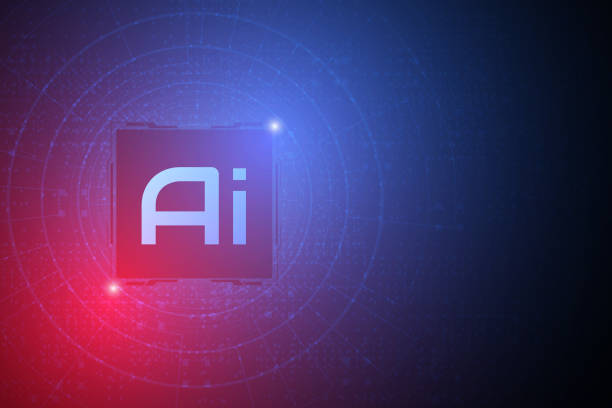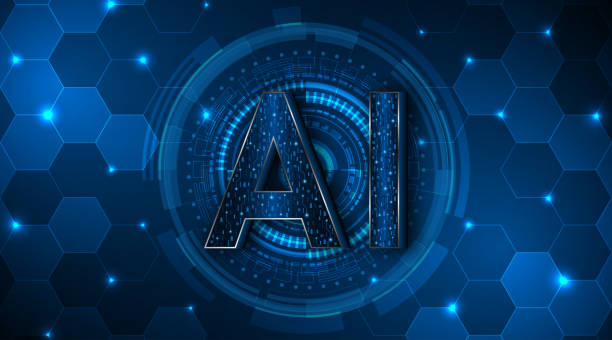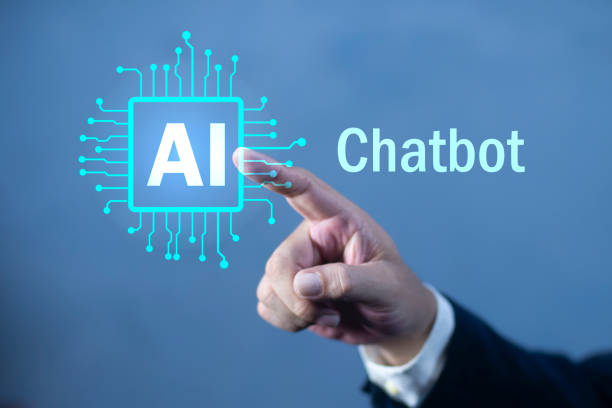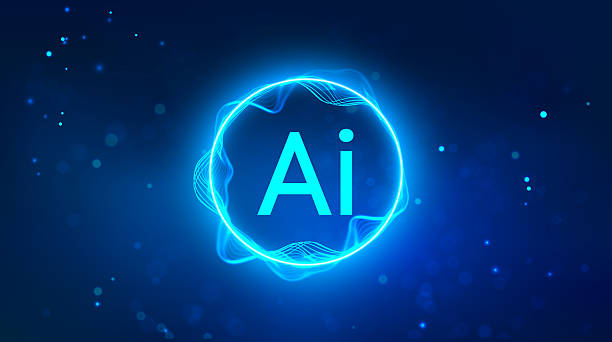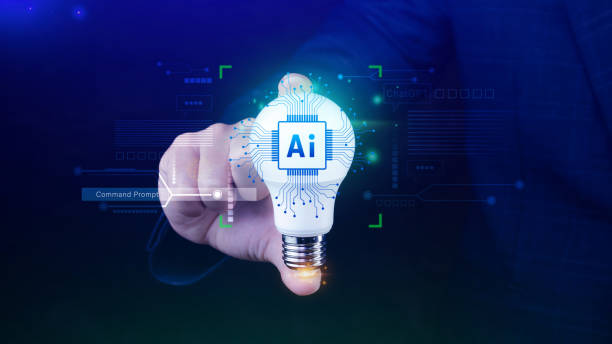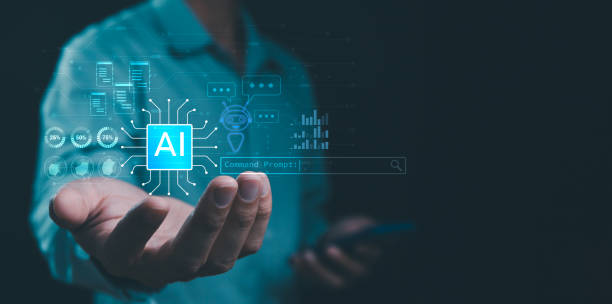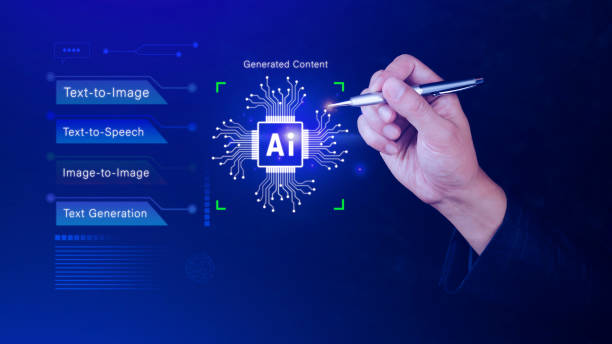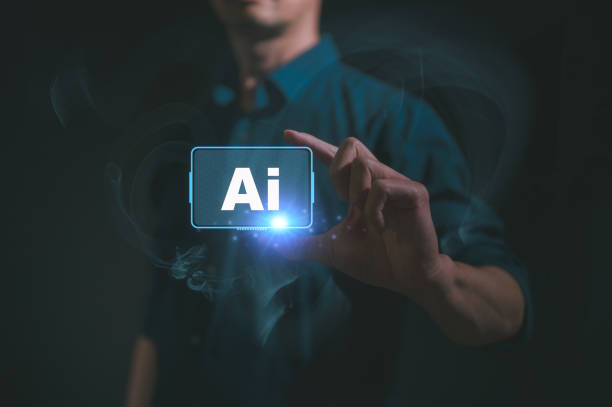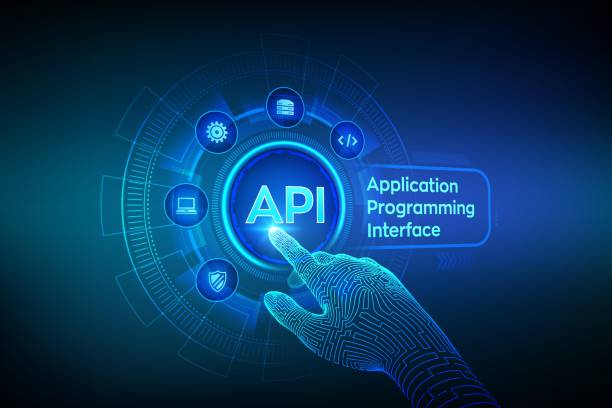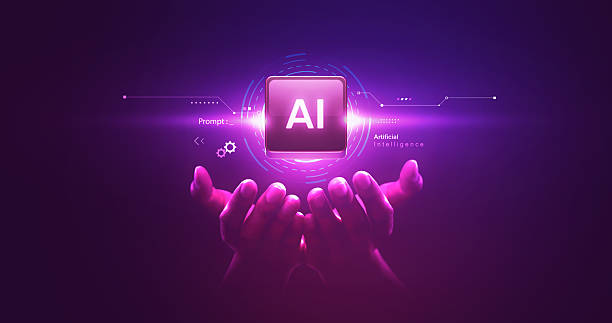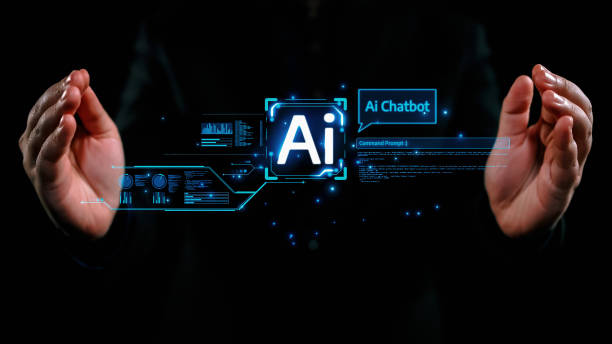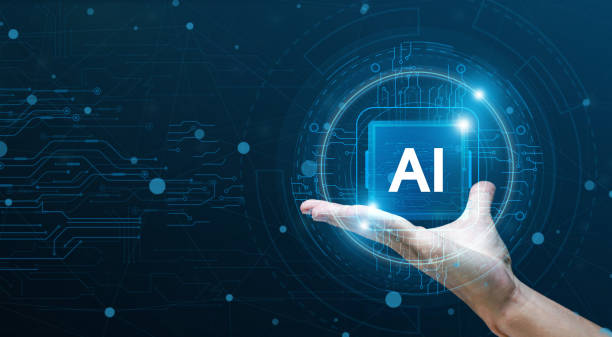### What is an Artificial Intelligence Robot and How Does it Work?
#Artificial_Intelligence_Robot is a combination of two technology fields: #Artificial_Intelligence (AI) and #Robotics.
In simple terms, AI robots are robots that use algorithms and AI models to perform various tasks.
These tasks can include pattern recognition, decision-making, learning from data, and interacting with the environment.
The general working process of an AI robot includes the following steps:
- Information Reception: The robot collects information from the environment through its sensors (such as cameras, microphones, touch sensors, etc.).
- Information Processing: The collected information is processed by the robot’s processors using artificial intelligence algorithms. This processing can include object recognition, sound recognition, text analysis, etc.
- Decision Making: Based on the processed information, the robot makes decisions to perform its tasks. These decisions can include movement, object manipulation, answering questions, etc.
- Execution: The robot executes its decisions using its actuators (such as motors, arms, etc.) and interacts with the environment.
- Learning: The robot can learn from its experiences and improve its performance. This learning can be done through machine learning algorithms, such as reinforcement learning.
In short, an AI robot is a complex system that uses artificial intelligence to enhance robotic capabilities. This powerful combination enables the creation of robots that can perform more complex tasks than traditional robots. AI robots have revolutionized industry and daily life.
Are you dissatisfied with the low sales of your online store?
Rasaweb is your solution for having a professional and high-selling online store.
✅ Significant increase in sales and revenue
✅ Easy and enjoyable shopping experience for customers
⚡ Get a free consultation from Rasaweb right now!
Types of Artificial Intelligence Robots Based on Application
AI robots are divided into various categories based on their different applications. Some of the most important types of AI robots include:
- Industrial Robots: These robots are used in factory production lines to perform tasks such as welding, painting, packaging, and assembling parts. They usually have high accuracy and speed and can work continuously.
- Service Robots: These robots are designed to provide services to humans. Examples of service robots include cleaning robots, nursing robots, delivery robots, and information robots in shopping centers and airports. AI service robots help facilitate life.
- Medical Robots: These robots are used in surgery, rehabilitation, drug delivery, and other medical fields. Surgical robots can be highly accurate and assist surgeons in performing complex operations.
- Military Robots: These robots are used in reconnaissance, bomb disposal, patrolling, and other military tasks. Using robots in these areas can reduce the risk of casualties for soldiers.
- Space Robots: These robots are used for exploring other planets, repairing satellites, and performing other tasks in space. Space robots must be able to withstand harsh space conditions.
- Personal Robots: These robots are designed for use in the home. Examples of personal robots include toy robots, language learning robots, and entertainment robots. Personal AI robots are becoming increasingly popular.
Click here to preview your posts with PRO themes ››
This classification is only a part of the types of AI robots that exist, and with the advancement of technology, we will see the emergence of new robots with more diverse applications. Currently, there is a strong focus on developing smarter and more independent robots that can operate in complex and unpredictable environments. AI robots are gradually becoming an integral part of our lives.
Main Components of an Artificial Intelligence Robot
An AI robot consists of various components, each playing an important role in its overall performance. The most important of these components include:
- Sensors: Sensors collect information from the surrounding environment. This information can include images, sounds, temperature, pressure, etc. There are different types of sensors, each designed to collect a specific type of information.
- Processors: Processors process the information collected by the sensors and make decisions based on it. Processors typically use AI algorithms to process information.
- Actuators: Actuators are responsible for moving the robot and interacting with the environment. Actuators can include motors, arms, wheels, etc.
- Power Source: The robot needs a power source to function. The power source can include batteries, fuel cells, etc.
- Software: Software is the mastermind of the robot and controls all its components. The software includes AI algorithms, operating systems, and other applications.
Interaction and coordination between these components are essential for the proper functioning of the robot. For example, sensors collect information, processors analyze the information and make decisions, and actuators execute the decisions. The software manages and controls all these processes. AI robots with these components and interactions are capable of performing complex tasks.
Here is a table to show some of the common sensors and their applications:
| Sensor Type | Application |
|---|---|
| Camera | Object recognition, navigation, monitoring |
| Microphone | Sound recognition, speech recognition, communication |
| Touch Sensors | Contact detection, force detection |
| Temperature Sensors | Temperature measurement |
| Pressure Sensors | Pressure measurement |
Artificial Intelligence Algorithms Used in Robots
Artificial intelligence algorithms play a vital role in the performance of intelligent robots. These algorithms allow robots to learn from data, make decisions, and interact with their environment. Some of the most important AI algorithms used in robots include:
- Machine Learning: These algorithms allow robots to learn from data without being explicitly programmed. There are different types of machine learning algorithms, including supervised learning, unsupervised learning, and reinforcement learning.
- Neural Networks: Neural networks are models inspired by the structure of the human brain. These networks can be used for pattern recognition, data classification, and prediction.
- Natural Language Processing (NLP): These algorithms allow robots to understand and interact with human language. NLP is used for applications such as answering questions, language translation, and text generation.
- Computer Vision: These algorithms allow robots to understand images and recognize objects. Computer vision is used for applications such as navigation, face recognition, and quality inspection.
- Planning: These algorithms allow robots to plan a series of actions to achieve a specific goal. Planning is used for applications such as navigation, object manipulation, and performing complex tasks.
Choosing the right algorithm depends on the specific application of the robot. For example, an industrial robot whose task is to assemble parts may use computer vision and planning algorithms. A service robot that is responsible for answering customer questions may use NLP algorithms. AI robots, by utilizing these algorithms, are capable of performing diverse and complex tasks.
Are you tired of your company’s website not meeting your expectations? Design a professional website with Rasaweb that showcases the true face of your business.
✅ Increase in attracting new customers and sales leads
✅ Increase in credibility and trust in your brand among the audience
⚡ Get free website design consultation!
Challenges Facing the Development of Artificial Intelligence Robots
Despite the significant advancements in robotics and artificial intelligence, there are still numerous challenges facing the development of AI robots. Some of the most important of these challenges include:
- Cost: Developing and building AI robots can be very expensive. This is due to the need for expensive parts, complex software, and high engineering expertise.
- Complexity: Designing and programming AI robots is very complex. This is due to the need for a deep understanding of both robotics and artificial intelligence.
- Security: AI robots can be vulnerable to cyberattacks. These attacks can cause robots to exhibit unwanted behaviors or leak sensitive information.
- Ethics: The use of AI robots raises many ethical questions. For example, if a robot causes harm to a human, who is responsible? Or should robots have rights?
- Social Acceptance: Some people may be resistant to the use of robots in everyday life. This resistance may stem from fear of job loss, security concerns, or distrust of robots.
Overcoming these challenges requires the joint efforts of researchers, engineers, policymakers, and the public. By developing new technologies, reducing costs, increasing security, and developing appropriate laws and regulations, we can pave the way for wider acceptance of AI robots in society. AI robots have great potential to improve our lives, but they must be developed with caution and responsibility.
The Future of Artificial Intelligence Robots and Its Impact on Human Life
The future of AI robots looks very bright. With continuous advancements in artificial intelligence and robotics, robots are expected to play a more prominent role in our lives in the coming years. Some of the most important potential impacts of AI robots on human life include:
- Increased Productivity: Robots can perform repetitive and tedious tasks with high speed and accuracy, which can lead to increased productivity in various industries.
- Creating New Jobs: The development, construction, and maintenance of robots will create new jobs.
- Improved Quality of Life: Robots can help provide services to the elderly, disabled, and patients, which can lead to an improved quality of life for them.
- Scientific Progress: Robots can help scientists explore space, conduct research in dangerous environments, and perform complex experiments, which can lead to scientific progress.
- Changing the Nature of Work: With the automation of many tasks, the nature of work will change. People need to learn new skills to be able to work alongside robots.
However, it should be noted that the development of AI robots will also bring challenges. For example, some jobs may be lost and economic inequality may increase. Therefore, policymakers and society as a whole need to be prepared to face these challenges and take the necessary measures. AI robots, with all their advantages and disadvantages, will be part of our future.
Applications of Artificial Intelligence Robots in Industry
Artificial intelligence robots are transforming various industries. They can perform tasks that are dangerous, difficult, or tedious for humans. Some of the most important applications of AI robots in industry include:
- Manufacturing: Robots are used in production lines for welding, painting, packaging, and assembling parts. They can work continuously and with high accuracy, which leads to increased productivity and reduced costs.
- Warehousing: Robots are used in warehouses for moving goods, sorting products, and packing orders. They can quickly and accurately locate goods and move them to the desired destination.
- Transportation: Robots are used in the transportation of goods and raw materials. They can automatically drive trucks, trains, and ships, which leads to reduced costs and increased safety.
- Agriculture: Robots are used in agriculture for planting, tending, and harvesting crops. They can accurately plow the land, plant seeds, fertilize, and harvest crops.
- Construction: Robots are used in construction for performing tasks such as bricklaying, concrete pouring, and welding. They can work quickly and with high accuracy, which leads to reduced costs and increased safety.
Artificial intelligence robots help companies increase their productivity, reduce their costs, and improve the quality of their products. With the advancement of technology, the applications of AI robots in industry are expected to expand and they will play a more important role in the global economy. AI robots are shaping the future of industry.
| Industry | Application of AI Robots | Advantages |
|---|---|---|
| Manufacturing | Welding, Painting, Assembly | Increased speed, accuracy, reduced errors |
| Warehousing | Moving Goods, Sorting, Packaging | Space optimization, reduced processing time |
| Transportation | Autonomous Driving, Delivery | Reduced accidents, reduced costs |
| Agriculture | Planting, Harvesting, Irrigation | Increased yield, reduced water consumption |
The Role of Artificial Intelligence Robots in Medicine and Healthcare
Artificial intelligence robots have great potential to transform medicine and healthcare. They can assist doctors in diagnosing diseases, performing surgeries, and providing better care to patients. Some of the most important applications of AI robots in medicine and healthcare include:
- Disease Diagnosis: Robots can diagnose diseases with high accuracy by analyzing medical images such as MRI and CT scans. They can detect patterns in images that may be hidden from the human eye.
- Surgery: Surgical robots can assist surgeons in performing complex operations with high accuracy. They can eliminate hand tremors and provide a better view of the surgical site.
- Rehabilitation: Robots can assist patients in performing rehabilitation exercises. They can control the movements of patients and provide accurate feedback on their performance.
- Drug Delivery: Robots can deliver drugs accurately and on time to patients. They can prevent medication errors and help patients take their medications correctly.
- Elderly Care: Robots can assist the elderly in performing daily tasks such as eating, dressing, and bathing. They can care for the elderly and help them live independently.
Artificial intelligence robots can help improve the quality of medical care, reduce costs, and increase access to healthcare services. AI robots are growing in the medical field.
Are you tired of your company’s website not being seen as it should be and losing potential customers? Solve this problem forever with professional and effective website design by Rasaweb!
✅ Increase brand credibility and build customer trust
✅ Attract targeted sales leads
⚡ Contact us now for a free consultation!
Artificial Intelligence Robots and Ethical Issues
Along with the development and widespread use of AI robots, important ethical issues are also raised that require careful attention and consideration. Some of these issues include:
- Accountability: If a robot causes harm to a human, who is responsible? Will the robot’s manufacturer, programmer, or user be responsible? Determining liability in these cases can be very difficult.
- Privacy: Robots can collect a lot of information about our lives. How can this information be protected and prevented from being misused?
- Discrimination: Artificial intelligence algorithms can inadvertently be discriminatory. How can we prevent the creation of algorithms that discriminate against certain groups of people?
- Job Security: With the automation of many tasks by robots, many jobs may be lost. How can new jobs be created for these people and prevent social harm caused by unemployment?
- Autonomy: To what extent should robots be given autonomy? Should robots be able to make independent decisions, even if these decisions conflict with human values?
Answering these questions requires discussion and dialogue between various experts, policymakers, and the public. Appropriate laws and regulations need to be developed to regulate the development and use of AI robots to prevent ethical harm. AI robots should be designed and used in a way that benefits society and respects human values. AI robots should not be developed without considering ethics.
How to Learn and Train Artificial Intelligence Robots
Learning and training AI robots is a complex and multi-stage process that involves the use of machine learning algorithms and appropriate training data. In general, the main steps in learning and training an AI robot are:
- Data Collection: First, appropriate training data must be collected. This data can include images, sounds, text, or other types of data. The quality and quantity of the training data have a great impact on the performance of the robot.
- Data Pre-processing: The collected data may have noise, incomplete information, or inappropriate format. Therefore, before using the data for training, it must be pre-processed.
- Selection of Machine Learning Algorithm: There are different algorithms for machine learning. Choosing the right algorithm depends on the type of data and the type of task that the robot must perform.
- Model Training: Using the training data and machine learning algorithm, a model is built. This model can be used for prediction, classification, or other tasks.
- Model Evaluation: The performance of the model should be evaluated on test data. If the performance of the model is not satisfactory, the parameters of the model should be adjusted and the training process repeated.
- Model Deployment: After the model reaches satisfactory performance, it can be deployed on the robot.
- Continuous Improvement: The performance of the robot should be continuously monitored and, if necessary, the model should be trained with new data to improve its performance.
AI robots, using this process, are able to learn and improve their performance over time. Continuous learning is one of the key features of AI robots.
Frequently Asked Questions
| Row | Question | Answer |
|---|---|---|
| 1 | What is an AI robot? | An AI robot is a machine capable of understanding, reasoning, learning, and problem-solving, and can perform complex tasks with relative autonomy. |
| 2 | What are the most important applications of AI robots? | The main applications include industrial manufacturing, customer service (chatbots), medicine and surgery, self-driving transportation, space exploration, and military affairs. |
| 3 | What is the main difference between an AI robot and a regular robot? | A regular robot only follows programmed instructions, while an AI robot can learn from data, make decisions, and adapt to new environments. |
| 4 | How do AI robots learn? | They improve their performance by identifying patterns through machine learning algorithms (such as deep learning, reinforcement learning) and processing vast amounts of data. |
| 5 | Can AI robots have emotions? | Currently, AI robots do not have real emotions in the human sense. They can mimic or recognize emotions, but they do not have the understanding and experience of them. |
| 6 | What are the current limitations of AI robots? | Limitations include the need for a lot of data, the inability to understand abstract concepts, the lack of true creativity, ethical issues, and the challenges of generalizability in new environments. |
| 7 | What is the role of AI in the development of humanoid robots? | AI helps humanoid robots walk, maintain their balance, understand the environment, interact with humans, and perform complex tasks. |
| 8 | How is the future of AI robots predicted? | AI robots are predicted to become smarter, more autonomous, and capable of performing more complex tasks in everyday life and industry, and their interaction with humans will increase. |
| 9 | Can AI robots replace all human jobs? | It is unlikely that all human jobs will be replaced. Robots will take over many repetitive and dangerous tasks, but jobs that require creativity, empathy, and ethical judgment will remain. |
| 10 | What ethical and social challenges arise with the expansion of AI robots? | Challenges include issues related to privacy, data security, ethical decision-making by robots, impact on employment, and accountability in case of errors. |
And other services of Rasa Web Advertising Agency in the field of advertising
Smart Google Ads: An exclusive service for growing website traffic based on the use of real data.
Smart Conversion Rate Optimization: Designed for businesses looking to attract customers by customizing the user experience.
Smart Direct Marketing: Professional optimization to improve SEO ranking using Google Ads management.
Smart Link Building: Professional optimization to increase website traffic using precise audience targeting.
Smart SEO: An effective tool to increase sales with the help of real data.
And more than hundreds of other services in the field of internet advertising, advertising consulting and organizational solutions
Internet Advertising | Advertising Strategy | Advertorial
Sources
What is a smart robot and what are its uses?
,What is a marketing robot and how does it work?
,What is a robot? — Definition, types and applications in simple language (+ free training video)
,Uses of smart robot in everyday life
? If you are looking to upgrade your business in the online space, Rasaweb Afarin Digital Marketing Agency, with its expertise in corporate website design and providing comprehensive digital marketing solutions, is ready to help you reach your goals.
📍 Tehran, Mirdamad Street, next to the Central Bank, Southern Kazerun Alley, Ramin Alley No. 6

